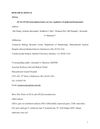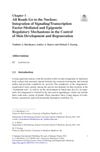Search
for
Did you mean Terminal Differentiation?
Learn
5 / 5 resultslearn Stem Cell Factor
learn Osteopontin
signaling protein that, when suppressed, may grow hair by reducing inflammation and stem cell loss
learn Follistatin
glycoprotein that inhibits TGF-β and promotes hair growth by antagonizing activin
learn Overview
Research
5 / 1000+ resultsresearch Chromatin Architectural Protein CTCF Regulates Terminal Keratinocyte Differentiation in the Developing Epidermis and Hair Follicles
CTCF protein is essential for skin and hair follicle development in mice.

research AP-2α/AP-2β Transcription Factors Are Key Regulators of Epidermal Homeostasis
AP-2α and AP-2β proteins are essential for healthy adult skin and hair.

research Regulation of Epidermal Proliferation and Hair Follicle Cycling by Synthetic Photostable Retinoid EC23
The synthetic retinoid EC23 thickens skin and promotes hair growth more effectively and with a lower dose than natural retinoids.

research All Roads Lead to the Nucleus: Integration of Signaling, Transcription Factor-Mediated, and Epigenetic Regulatory Mechanisms in the Control of Skin Development and Regeneration
The nucleus is key in controlling skin growth and repair by coordinating signals, gene regulators, and epigenetic changes.

research Chromatin Architectural Protein CTCF Controls Epidermal Barrier Formation, Hair Follicle Fate Maintenance, and Suppresses Inflammatory Responses in the Skin Epithelium
The protein CTCF is essential for skin development, maintaining hair follicles, and preventing inflammation.
Community Join
5 / 591 results
community Minoxidil Response Bottlenecks: Why Sulfation and Transport Matter (And Where Tretinoin Fits In)
Minoxidil's effectiveness is limited by the need for sulfation and proper transport to hair follicles, with tretinoin potentially enhancing its effects by promoting enzyme activity and keratinocyte differentiation. Tretinoin may improve minoxidil's response by boosting the expression of necessary enzymes and transporters.

community Compressed part of research of theory of androgenic/anabolitic balance. AGA h-responders analytic. Theory of physio-metabolitic method of anti AGA treatment
The treatment for androgenetic alopecia involves using finasteride and minoxidil with intense exercise and cold exposure to boost metabolism and reduce androgenic effects, potentially leading to hair regrowth. This approach may activate biological pathways for improved hair and overall health.
community HairClone developing cell replacement treatments for Hair Loss
HairClone is developing cell replacement treatments to rejuvenate and generate hair follicles, and has launched a crowdfunding campaign. A user expressed skepticism about the need for crowdfunding.
community 30-Min Dermatology Visit – Best Questions to Ask About Balding? ( 175$ )
The conversation discusses hair loss treatments, focusing on finasteride, minoxidil, and other options like PRP and ketoconazole. It highlights the importance of asking specific questions during a dermatology visit to determine the cause of hair loss and appropriate treatments.
community Efficacy and Tolerability of N-Acetyl-Cysteine for Treatment of The Early-onset Androgenetic Alopecia in Men
N-Acetyl-Cysteine (NAC) was found to improve hair parameters in men with early-onset androgenetic alopecia, showing increased terminal hair count and decreased vellus hair count, with good tolerability. NAC, used alone or with minoxidil, may help due to its antioxidant properties, though its effectiveness can vary among individuals.